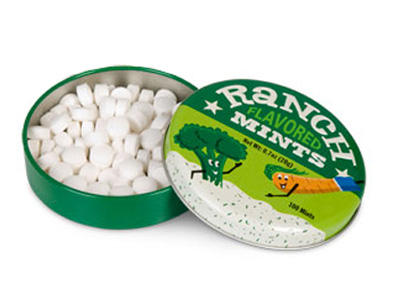Several months back, while squandering time searching Amazon.com, I saw an advance publication notice for Kim Flottum's new book, Better Bee Keeping: The Ultimate Guide to Keeping Stronger Colonies and Healthier, More Productive Bees. Sadly, when someone includes words like "Ultimate", "Extreme" or "Ranch Flavored" in the name of their product, I'm drawn toward it like a moth to a flame. Further, since its subject would fit so well into my beekeeping library, I added Mr. Flottum's yet to be published work to my calendar so I could buy it as soon as it came out.
 |
| It's wrong, but I'd probably buy them... |
 |
| Kim Flottum |
Time vs. Money
When it comes to building a beekeeping business, Mr. Flottum suggests approaching it with the mindset of investing your capital in ways that allow for the best use of your time. I've learned the hard way how quickly I can get bogged down in the minutea of getting a business up and running, only to find out after the fact that outsourcing a lot of the details, even if I drew pride and satisfaction from them, would have been a more profitable use of my time. Further, taking on those non value added aspects become a bottleneck for growth. In beekeeping, it feels like time well spent to assemble hive bodies, supers and a few score of frames and foundation to run a couple of hives in the back yard. One may even call it fun. But when you're adding ten nucs, a half dozen packages and looking to do several splits on the twenty or so colonies you hope make it through winter, all those details can turn from satisfying joy to a loathsome chore. However, where reality and practicality cross paths, it can be hard to justify some expenditures. For instance, whereas I may strongly consider the added cost of buying pre-assembled frames and beeswax coated plastic foundation to free up time, I can't justify the investment in a chain uncapper. But I will say that Kim's philosophy reminds me that when entrepreneurial efforts consume all of your spare time, they start taking time away from other things you need or want to do. So it would seem important keep a sharp eye on how time is best spent.
Renting Land
Keeping bees can be a downright hassle, particularly if you live in an urban or suburban environment. Bees drinking out of neighborhood swimming pools, flying around flood lights at night, invading aluminum can recycle bins, meddlesome crumb snatchers hell bent on aggravating the bees with their water cannon do hickeys, overuse of pesticides and herbicides all make it tough to be both a good neighbor and a good beekeeper. So many of us go in search of bee yards away from all that stuff. And if we're lucky enough to find a secluded area not too far from home that doesn't cost us any money, we hit the trifecta. If there are good nectar and pollen sources close by or if there is a convenient water source, that's just icing on the cake. We're just happy to get to keep bees without being hassled, but more often than not end up with the bee yards we can get instead of the bee yards we want. Kim suggests seeking out the bee yards we want and approaching the owners about renting the land from them, maintaining that the increased production and decreased frustration yielded by the "perfect spot" will justify the cost. I think he's got a point and decided to pursue it. I've got several hives on a piece of property I own. It's a good area: secluded, lots of wildflowers, a few ponds around. However, the entire site is covered in pine trees, which provide too much shade; particularly when it comes to controlling small hive beetles. The piece of land that borders mine is a 20 acre field of broom straw that gets bush hogged once a year. So I sent the owner a letter expressing an interest in renting it. With that kind of acreage, I can move my hives out in the sun, have the land plowed and planted with what whatever nectar sources I want and have plenty of room to expand my number of colonies. For the owner, they don't have to maintain the field anymore and they get paid. Hopefully, they see it as a win/win too. Stay tuned...
Queen Rearing
At our state beekeepers meeting this summer the overarching theme was queen rearing. Seminars and short courses on the subject were plentiful and well attended. No doubt, there's a big push for beekeepers to make raising queens part of their normal beekeeping tool kit, and in my opinion, this subject was given more detail than other topics in the book. Don't get me wrong. You won't be an expert on raising queens after reading this book, but you'll know enough about it to realize that it is far from easy. Much like settling for the land we can get, Kim purports we often settle for the queens we can get. Quoting a long time friend of his he theorizes that in a purchase of 10 queens, 2 will be dead or immediately superseded, 2 will produce progeny with above average honey yields while the other 6 produce progeny with an average honey yield. In other words, a normal bell curve: 20% outstanding; 20% below average; and the majority, so-so.
 |
| Only queen I've ever "raised". She's a great one, but it appears it was dumb luck. |
Conclusion
If you want to learn how to start beekeeping, Better Beekeeping isn't for you. However, if you're looking to start or expand your beekeeping business, this book would be worth buying. Although it isn't a detailed manual, it does give you a plethora of subjects on which further research may be beneficial to your business ventures.
If you'd like to be notified of updates to this blog, please email me at beeswax@teezbees.com. I promise your email address will not be shared with anyone.
If you're interested in learning more about beekeeping, join a local beekeepers association as well as your state's beekeepers association. Explore your state's master beekeeper program if they have one. The following links can get you started:
South Carolina
Georgia
North Carolina





































